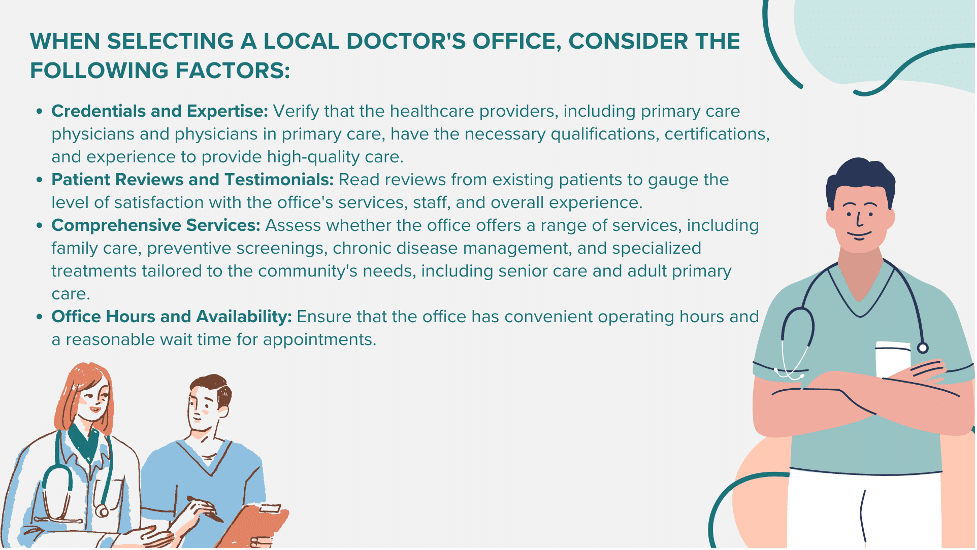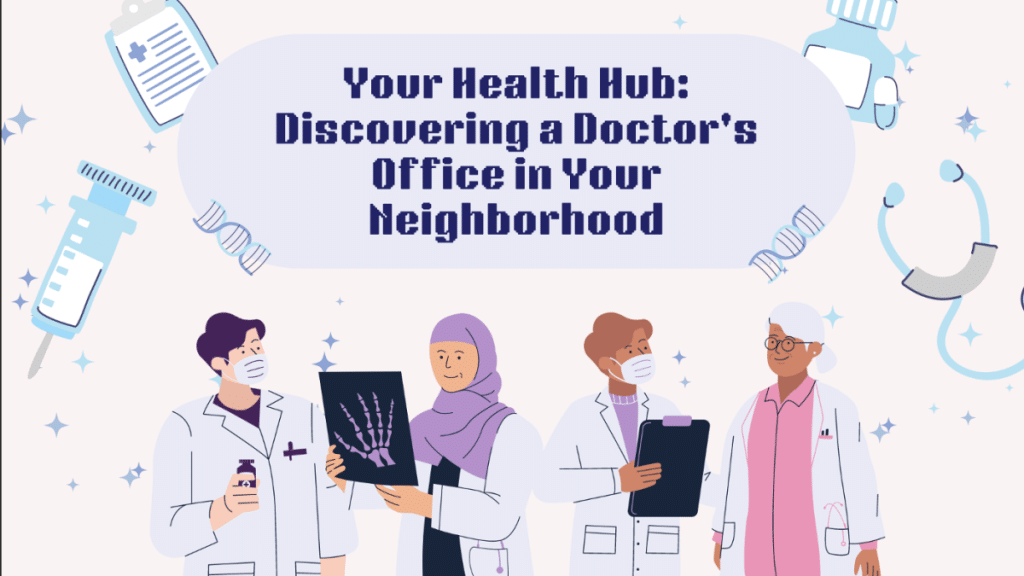Do you feel a tickle in your throat or experience a nagging pain? While a quick internet search might offer temporary relief, wouldn’t it be amazing to have a trusted doctor’s office right around the corner? Your neighborhood could be hiding a hidden gem – a health hub that caters to all your needs. This guide will help you unlock the door to finding the perfect doctor’s office, transforming your local area into your very own healthcare haven.
Evaluating Local Healthcare Needs
Access to quality healthcare is a fundamental necessity for every community. However, the specific healthcare needs of a neighborhood can vary significantly depending on factors such as demographics, socioeconomic status, and prevalent health conditions. Understanding these unique needs is crucial in ensuring that the available healthcare services are tailored to meet the demands of the local population.
In Wheeler County, for instance, the aging population and a high prevalence of chronic conditions like diabetes and heart disease have created a pressing need for specialized care and preventive health initiatives. By carefully evaluating these local healthcare needs, community leaders and healthcare providers, including primary care physicians and adult gerontology primary care providers, can make informed decisions about the types of services and resources that should be prioritized.
The Role of Accessibility in Choosing a Local Doctor’s Office
While identifying healthcare needs is essential, addressing accessibility barriers is equally important. Limited access to healthcare can have severe consequences, ranging from delayed diagnoses to poor health outcomes. This is particularly true in rural areas like Wheeler County, where residents often face challenges such as long travel distances and limited transportation options.
In such scenarios, having a doctor’s office near me can be a game-changer. Choosing a local doctor’s office can mitigate these accessibility barriers, providing residents with convenient access to routine check-ups, preventive screenings, and timely medical care during emergencies. Additionally, local healthcare providers, including primary care physicians and adult primary care providers, are often deeply rooted in the community, fostering trust and facilitating better communication between patients and healthcare professionals.
What to Look for in a Local Doctor’s Office
While ensuring a doctor’s office is within reach is vital, knowing what to look for in these offices will further guarantee you receive the best possible care. This includes evaluating credentials, patient feedback, and service offerings, crucial elements especially in areas with limited options.

By carefully evaluating these criteria, you can increase your chances of finding a local doctor’s office or health clinic that aligns with your healthcare needs and preferences.
Utilizing Technology to Streamline Healthcare
Besides the traditional criteria for selecting a healthcare provider, modern technology plays a pivotal role in transforming patient care. From online appointment systems to telehealth services, technological integration is streamlining the way we interact with our local health hubs.
Many doctor’s offices now offer online portals where patients can schedule appointments, access their medical records, and communicate with healthcare providers, including primary care physicians. This not only saves time but also enhances transparency and empowers patients to take an active role in managing their health.
Additionally, telehealth services have become increasingly popular, allowing patients to consult with healthcare professionals, such as primary care providers, remotely through video conferencing or secure messaging platforms. This technology is particularly beneficial for individuals living in rural areas or those with limited mobility, ensuring they can receive high-quality care without the need for extensive travel.
Comparison of Traditional and Tech-Enabled Healthcare Services
| Feature | Traditional | Tech-Enabled |
| Appointment Scheduling | Phone calls or in-person visits | Online scheduling portals |
| Medical Records Access | Paper files or in-person requests | Electronic health records (EHRs) |
| Provider Communication | In-person or phone calls | Secure messaging or video consultations |
| Specialist Consultations | Referrals and in-person visits | Telehealth services |
Integrating into Your Local Health Ecosystem
While finding the right local doctor’s office or provider near you is crucial, it’s also essential to actively participate in your community’s broader healthcare ecosystem. This involves engaging with local health initiatives, attending community health events, and utilizing available resources to promote overall well-being.
For example, the Health Resources & Services Administration (HRSA) offers a range of programs and services aimed at improving access to quality healthcare, particularly in underserved areas. By taking advantage of these resources, you can stay informed about the latest healthcare developments and connect with support systems that can enhance your healthcare journey.
Additionally, building a strong relationship with your local healthcare provider, whether a primary care physician or an adult primary care provider, is key to long-term health management. Open communication, trust, and collaboration can help ensure that your unique needs are addressed, and preventive measures are taken to maintain your overall well-being.
Challenges and Considerations
Despite the benefits of local healthcare services, residents often encounter barriers that can hinder access and optimal care. These challenges may include:
- Insurance Complexities: Navigating insurance plans, deductibles, and provider networks can be overwhelming, potentially limiting healthcare options, including access to primary care physicians.
- Limited Provider Availability: In some areas, there may be a shortage of healthcare professionals, leading to extended wait times or the need to travel long distances for specialized care or to find a primary care provider.
- Affordability Concerns: Out-of-pocket costs, such as copays and deductibles, can pose financial burdens, especially for those without adequate insurance coverage, making it difficult to afford primary care or senior care services.
While these challenges are significant, there are solutions and alternatives available. Community health programs, telehealth services, and advocacy efforts can help bridge gaps and improve healthcare accessibility. Additionally, organizations like the Rural Health Information Hub provide valuable resources and guidance for addressing rural healthcare challenges, including finding a primary care doctor or physician.
Frequently Asked Questions
How do I find out which doctors in my area accept my insurance?
To verify insurance acceptance, follow these steps:
- Contact your insurance provider and request a list of in-network healthcare providers, including primary care physicians, in your area.
- Utilize online directories provided by your insurance company to search for nearby doctors, health clinics, and facilities.
- Check the doctor’s office website or call their office directly to confirm that they accept your specific insurance plan.
What should I do if there are no specialists in my area?
If you require specialized care that is not readily available in your local area, consider the following options:
- Seek treatment at regional medical centers or larger healthcare facilities that offer a broader range of specialty services.
- Explore telehealth services that connect you with remote specialists through video consultations or secure messaging platforms.
- Discuss your options with your primary care provider, who may be able to provide referrals or recommendations for accessing specialized care.
How often should I visit my doctor if I’m generally healthy?
The frequency of routine check-ups and preventive care visits can vary based on individual factors such as age, health history, and risk factors. However, general guidelines suggest:
- Adults: Annual wellness visits with a primary care physician for preventive screenings and health assessments.
- Children and Adolescents: Regular well-child visits as recommended by pediatricians, typically annually or more frequently during developmental stages.
- Older Adults: More frequent visits, typically every 6 months or as recommended by healthcare providers, to monitor chronic conditions and address age-related health concerns with an adult primary care provider or senior care specialist.
It’s essential to consult with your healthcare provider to determine the appropriate schedule for routine check-ups and preventive care based on your specific health needs.
Conclusion
Discovering a local doctor’s office or provider near you that aligns with your healthcare needs and preferences can be a journey, but one that is well worth the effort. By understanding the importance of accessibility, evaluating local healthcare needs, and leveraging technology, you can make informed decisions and take an active role in managing your health.
Remember, your local doctor’s office is not just a place for medical treatment; it’s a hub for preventive care, health education, and building lasting relationships with healthcare professionals, such as primary care physicians and adult primary care providers, who understand the unique needs of your community.
